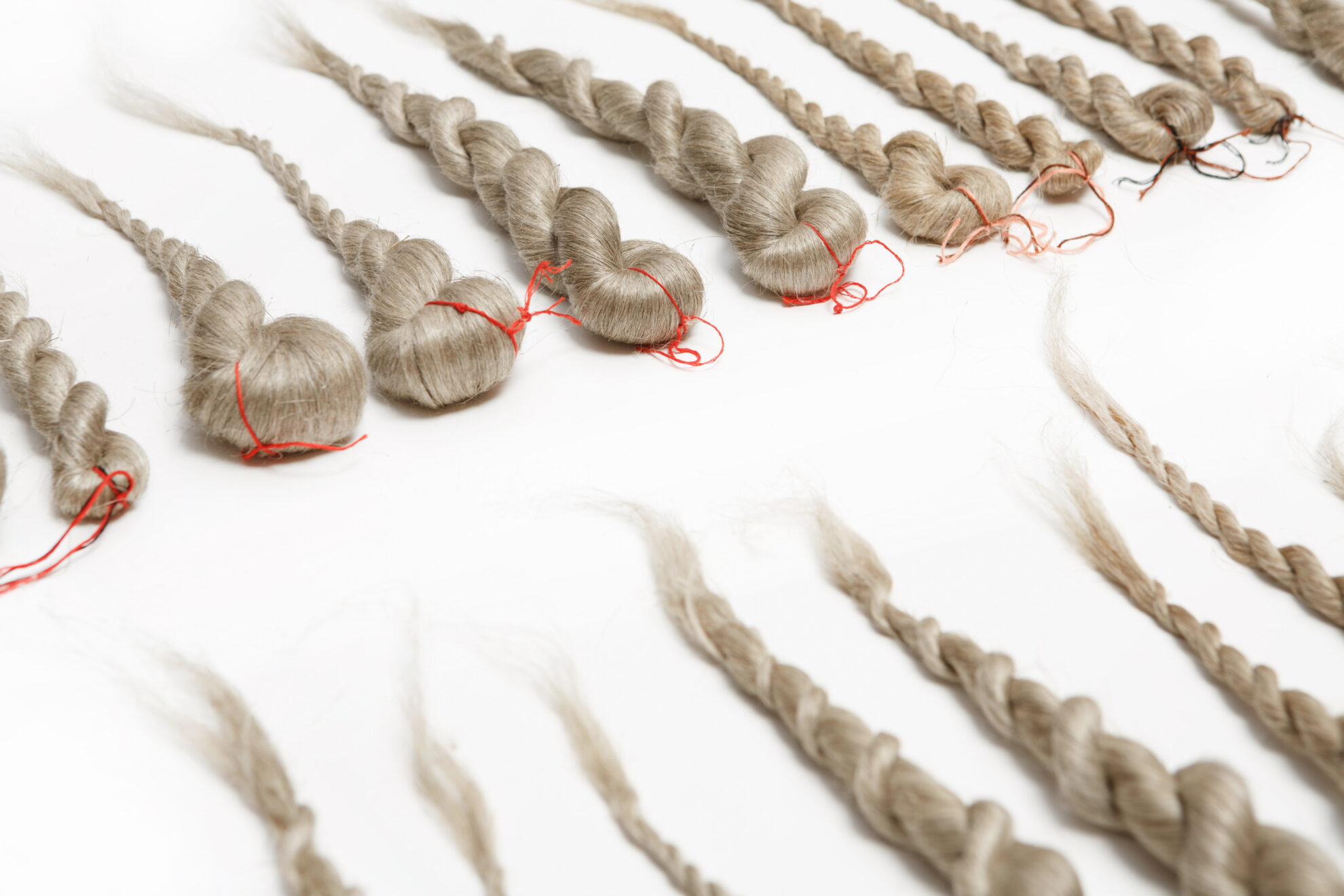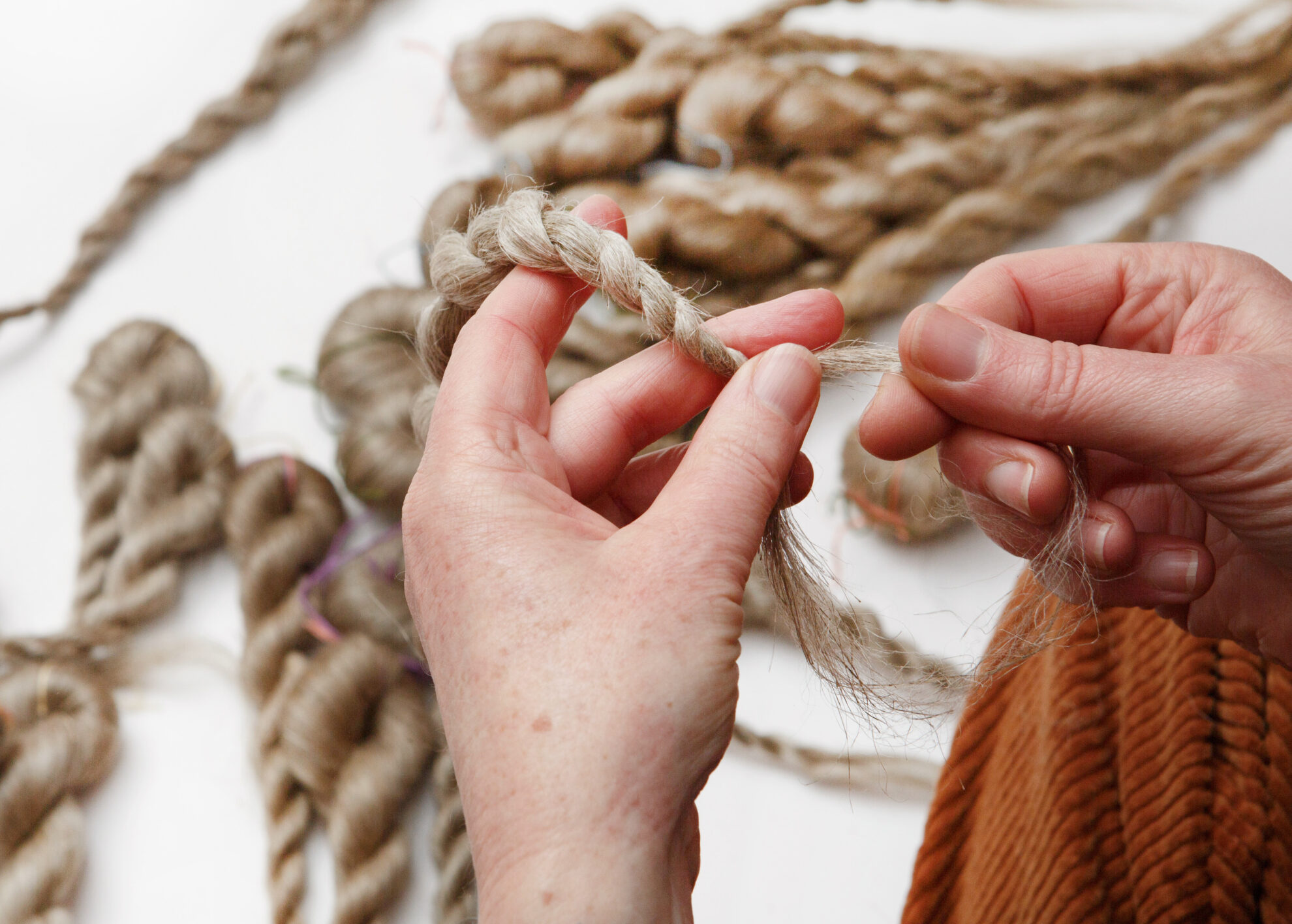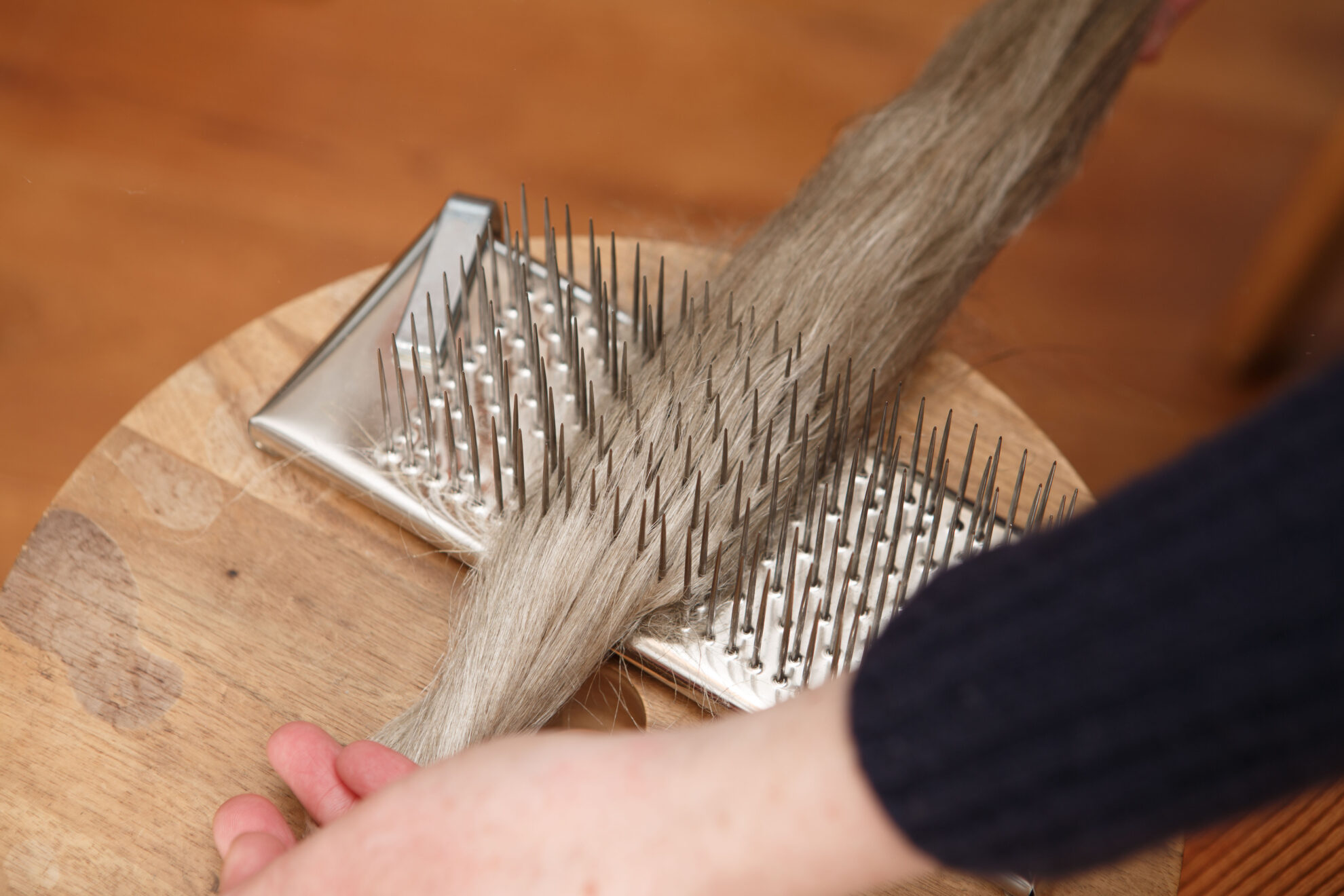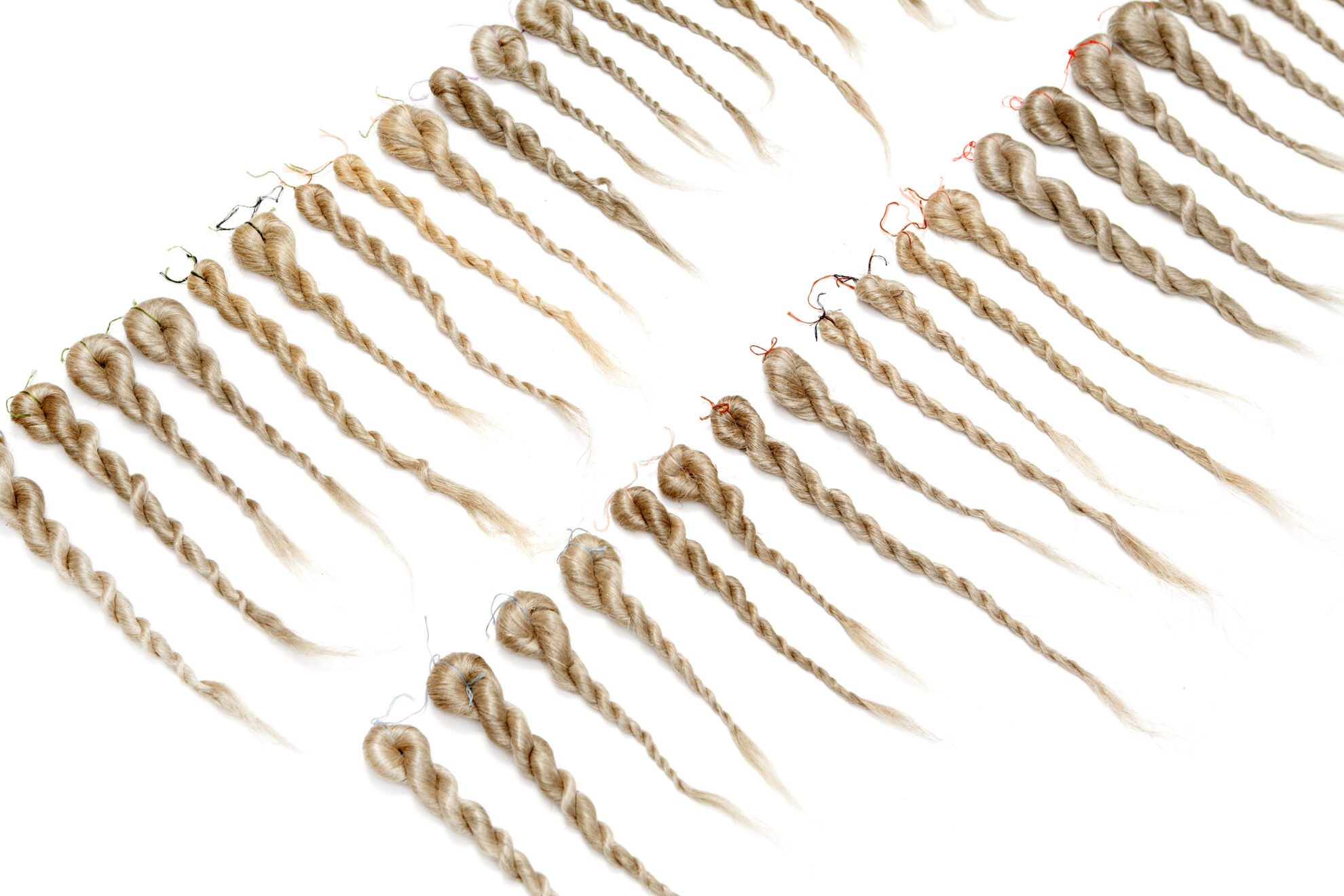Karin Wijnen’s flax research is an ode to diversity and curiosity
Text: Iris te Wieske
Photography: Fan Liao
On a small piece of land behind the old church in Oosterbeek, Karin Wijnen’s flax will soon germinate again. Last year she sowed six varieties of flax here. That brought her not only a beautiful collection of diverse flax stricks, but also a growing love and fascination for the process. I spoke with Karin about her work, which resulted in a story about endless possibilities, curiosity and creativity.

A house filled with love
I meet Karin at her home in Oosterbeek. The walk there is a joy in itself. It is cold but sunny as I walk along a wide street full of old trees toward her house. I hear a woodpecker that stops when I pause for a moment. At Karin’s home you immediately feel the love for and dedication to her work. There is a lot to see. I follow her to the living room where several hecklers hang on the wall. Wooden boards with iron pins, used to comb the flax fibers. As I study them, Karin shows me her flax break. Karin: ”You use it to break the wooden core of the flax stalks.”
In the kitchen, the table is covered with books about textiles. At the edge of the table a bowl with hand spindles. To spin with, Karin explains. As she pours us a cup of tea, I tell her I haven’t held flax in my hands before. She grabs a sturdy linen cloth, rolls out the braided flax stricks of her research, and places them between us on the table. Karin: ”I also like to be able to see and feel the material when I talk about it.”
The fact that Karin is now working with flax, is a coincidence. After studying musicology and a career on the flute, a search ensued. That search ended in cheese making. Karin: ”I wanted to make cheese the traditional way. With the living cultures of healthy cows, standing in a biodiverse pasture where all kinds of things grow. As I was learning that, I wanted to have cheese cloths. You used to have cloths from nettle. I liked that so much. If you use the fungi and bacteria from the environment for the cheese, you want a cloth that has contact with the environment, right?”
I wonder if nature has always been so important to her. Karin: ”I always loved being outside. I liked walking more than cycling. The slower, the more I could look around. I preferred to stand still everywhere. With cheese making, it was mainly the miraculous that fascinated me. Flax has that wonder too.”


The first seed
When a call for Linen Stewards came up at the Horsterhof (an organic farm in Duiven), Karin didn’t think twice about joining. It may not have been nettle, but it was similar. Because of corona, cheese making disappeared into the background, but the (flax) seed was planted. That seed turned out to be a study in itself. Karin: ”The commercial seed I use comes from Van De Bilt (a specialist in flax fiber and seeds) in Zeeland. From the beginning of the 20th century, seed was also bred in Friesland. That seed breeder is no longer there, but a group of people went to seed banks to look for seeds that were bred in Friesland at that time.’’
Karin explains that nothing happens to the seed in the seed banks. The seed is kept there to be used someday. Karin: ”In Friesland, they want to re-seed it every year to extract new seed. At a seed bank you get a very small amount of seed, but from this group we could buy a larger amount. That’s what we did with the Linen Stewards.”
After two years as a Linen Steward, she gets the chance to work on a small plot of land behind the old church, on the outskirts of Oosterbeek. Karin: ”You want to be able to stop by the field every day to see how things are going.”
The research on her own piece of land also began with the seed. Karin: ”I was interested in the types of seed I could use. That was because of a woman in Portugal, Alice Bernardo. She discovered that the seed that is available now, is very different from the seed that was used in Portugal in the past. The flax she sowed stayed a lot shorter. The scutching mills of today were not suitable for the shorter flax she grew and that got me thinking. We now have a type of flax in the Netherlands that has been selected for today’s mechanical processing. That intrigued me. How are choices made for certain seeds and if I had the opportunity could I not go for other flax? What qualities would I look for? That’s why I wanted to sow several varieties.”
You can find more about Alice Bernardo’s work here.
She recently received a grant to continue her project GatewayCrafts.
Have it both ways
In her research, Karin comes across all kinds of remarkable sources. She recently found a Dutch cultivation manual from 1809. Because of the war with France, fine French linen was not available at the time. However, there was a demand for it from the government. Thus began an inquiry into what made French and Belgian linen so different. Karin: ”A report was made, which was published in an agricultural magazine with a call for testing. A prize was given to the person with the finest linen.”
About the seed, the manual states that on clay soil, the flax seed from sandy soil should be used, and vice versa. Karin says: ”In those days a lot of seed came from the port of Riga to the Netherlands and Belgium. That was Baltic-Russian seed. They say that seed from a colder climate, that is sowed here in a warmer climate, grows longer and thus gives a better yield.”
That is why, from then on, almost all seed was imported from Riga. And that worked. The flax grew taller. Karin: ”Until 1800 we had flax here that grew only 50 centimeters high. With the Riga seed, the flax became 80-100 centimeters high. That’s almost double the yield.”
In the Netherlands we chose to harvest both the flax fiber (for linen) and the flax seed (for linseed oil, among other things). That too ensured a double yield, but it also had disadvantages. Karin: ”If you go for just the fiber, you pull earlier than the flax seed is ripe. If you only go for the seed, you actually pull too late to have a good quality fiber. We, as Dutch, have chosen a middle way, but that affects the quality of your fiber. Whether you mind that or not is the question. You now start from things we valued in a certain period of time. Of course, you might as well value something else, that’s what I find interesting!”
Spot the differences
Karin started by sowing three commercial and three historical varieties. The result is still laying in between us. With my fingers I glide along the fibers. Beautiful flax stricks, from short to long and from rough to silky, but also hugely different in color. I ask Karin if by now she has an idea of which flax suits her. Karin: ”Processing the flax into flax stricks was a lot of work. In all those hours I started to notice that by doing it slightly different you have a much bigger yield. I thought I could now start comparing the varieties, but my learning curve in processing has been so great that the variety I processed first can’t be compared to the last one. I’ve gotten much better at it.”


This spring Karin is going to sow flax again. She didn’t buy new seed, but is working with home-grown seed from last year. Karin: ”I still have the desire to try other varieties as well. For example, a variety with popping seed balls.” Karin laughs: ”Tricky though, because when they ripen they pop open and your seed is gone. So you have to respond to the flax even better.”
Everything is connected
I’m curious to hear what surprised her most about flax. Karin laughs: ”One thing? I’m still discovering all sorts of things! I was at De Schatkamer in the Sint-Servaasbasiliek the other day. There I saw a large linen cloth from the 12th century. It was made of such fine linen with motifs woven into it. How did they do that back then? But also the realization that we lost that knowledge. That already in 1809 a call came asking: how do they make such fine flax there, because we don’t know anymore.”
On her land, Karin grows various dye plants in addition to flax, including woad and madder. This, too, involves a lot of choices and patience. The orange roots of the madder have to grow for at least three years, but produce a beautiful red color. From the yellow flowering woad comes an intense blue color. For the final result, the processing of the linen makes a big difference Karin explains: ”When flax is retted in water, which is not actually allowed anymore, you get much paler flax than when you dew-root (on the field). This gives a much grayer flax. If you want to dye, your starting color affects the result.”
So Karin’s research goes far beyond sowing and harvesting the flax. Many factors, sometimes beyond her control, affect the process. Karin: ”At the Zeeuws Museum, I had the opportunity to study the collection of linen shirts. In this way I am also gaining knowledge. Of the cultivation and the choices involved, but also from the other side of the processing. Everything is connected and that’s what I find so interesting. This used to be quite separate in specializations, now I’m doing it all in one person.”

Abundance
Besides an exploration of flax, Karin’s research is about being fascinated by and loving her surroundings and rediscovering the things we have lost over the years. Her research also gets me thinking. Aren’t we, with our pursuit of productivity, efficiency and profit, losing our intrinsic curiosity and are we asking ourselves the right questions? And in the storm that life sometimes is, how do we make sure we don’t lose sight of the small wonders? This spring, I will be sowing flax myself. Maybe here is where I’ll find my answers.
I wonder what the research has brought Karin. Karin: ”The admiration for all the work they used to do. The fine spinning that they used to do, I will never match. But also the richness of what is possible. Nowadays we buy almost everything in stores, but there’s so much more possible than what you see there. With the things that grow directly in your environment or the things you throw away in your kitchen. For example, pomegranate peels, a huge source of tannin that you need for dyeing. And pruning waste from an apple tree. The bark of the apple tree also contains dyes. But also consider acorns, alder cones and walnut shells. Your creativity is greatly stimulated by that.”
Finally, I ask her if she has any tips for those who will be sowing flax themselves. Karin: ”Look at it every day and react to what you see happening. So if there are a lot of weeds in between, take out weeds. Or if the mice come by, they love the germinating seed, see if your seeds are still in the ground. If there has been a storm, bring everything up and don’t leave it. And when the flowers bloom, be sure to go look in the morning!”
